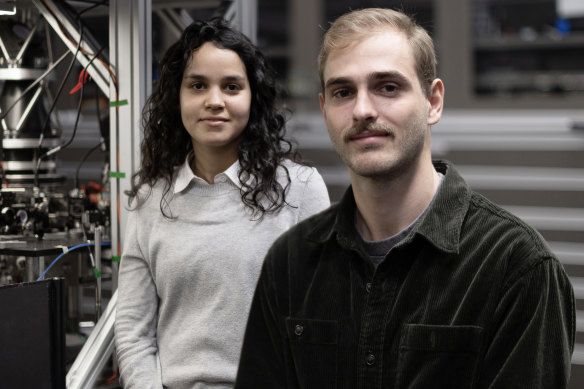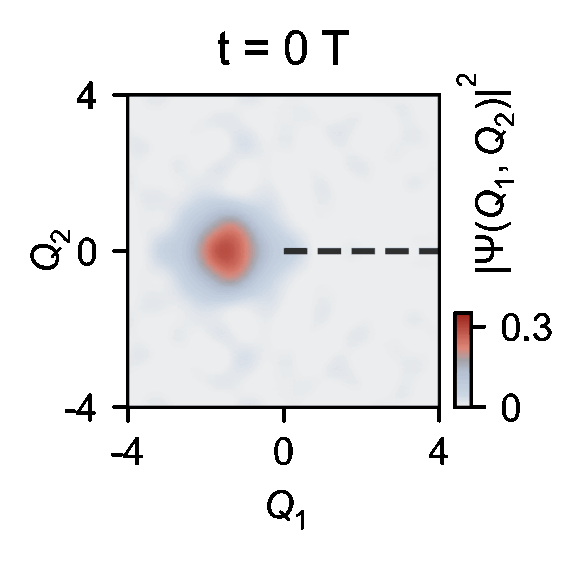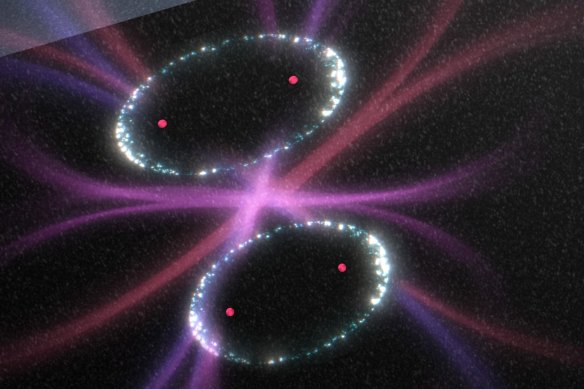By Angus Dalton
How long’s a femtosecond? Blink and you’ll miss it. A hundred trillion times.
Therein lies the challenge for scientists investigating chemistry’s most important processes, which are often impossible to observe because they are over in a femtosecond, or one quadrillionth of a second.
Now Sydney scientists have made one of Australia’s first practical quantum breakthroughs by using a quantum device to slow down a chemical interaction that underpins human vision or photosynthesis by 100 billion times, stretching the process from imperceptible femtoseconds to observable milliseconds.

Sydney scientists Vanessa Olaya Agudelo and Dr Christophe Valahu used a quantum device to slow down a chemical process by 100 billion times.Credit: Stefanie Zingsheim
It might not sound as thrilling as a Back to the Future escapade messing around with time travel, but the experiment has forged a pathway to understanding how the molecular makeup of our world – from our insides to the skies – really works, revealing atomic activity invisible not because of its size, but the extreme speed with which it unfolds.
The technique in the world-first experiment could lead to more efficient solar cells, better batteries, insights into atmospheric chemistry and new designs for drugs as more ultrafast reactions are mapped out.
“An electron microscope gives you more spatial resolution. Here we have more temporal resolution,” Associate Professor Ivan Kassal, a theoretical chemist at the University of Sydney and co-author of the new research, said.
“We’re able to slow down this process by millions and billions of times to make it easier to study, something chemists have been trying to do since the ’50s.”
The quantum researchers studied a funnel-shaped geometric structure called a conical intersection, common in reactions involving light.
These atomic funnels allow molecules excited by light to expel extra energy. They’re integral to the formation of smog, the breakdown of ozone, the process of photosynthesis and the protection of our DNA.
“The reason you get skin cancer is DNA absorbs light, and then that energy messes things up,” Kassal said. “There are often conical intersections in DNA, which allow that energy to be dissipated safely without causing damage.
“It’s the same principle of how sunscreen works – there are conical intersections in there allowing the energy to be dumped.”
For the experiment, scientists trapped an ion of ytterbium, a soft rare-earth metal, in a vacuum. Using quantum computing and an assortment of lasers, they ushered the ion through a simulated conical intersection and, for the first time, captured each stage of the slow-motion interaction.
“This allowed us to make meaningful observations and measurements,” said lead co-author and PhD student Vanessa Olaya Agudelo. “This has never been done before.”
The resulting animation shows the ion starting as a “single blob”, which then splits and travels around each side of the conical intersection before crashing back into itself on the other side.

The researchers were able to create a video of the process – the ion splits and travels around the conical intersection, behaving like a wave.Credit: Quantum Control Laboratory, The University of Sydney
“It’s very much showing that matter has these wave-like properties on very tiny scales,” Kassal said. “It’s super weird.”
The experiment demonstrates one of the first practical uses of quantum computing in Australia.
Traditional computers are shackled to binary code – ones and zeroes – but a quantum computer’s fundamental unit, a qubit, can exist in two states at once (that is one and zero), which vastly boosts computing power. It’s one thing to develop quantum hardware; creating ways to harness its enormous computing potential is another matter.
“The real question is, what will quantum computers be useful for soon? And what we’re showing is that simulating chemistry is really the way forward,” Kassal said.

Classic computers perform calculations using ones and zeros. Quantum computers use qubits, which are in a quantum state of both one and zero at the same time.Credit: Tony Melov / UNSW
As quantum hardware scales up, researchers will be able to model increasingly complex reactions.
“These kinds of ultrafast chemical processes are very difficult to simulate accurately on ordinary computers,” lead author Dr Christophe Valahu said. “The idea is that later on, you can scale this to more complex simulations.”
Liam Mannix’s Examine newsletter explains and analyses science with a rigorous focus on the evidence. Sign up to get it each week.